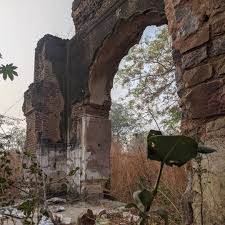.jpg)
.jpg)

The term "Mehram" carries cultural and religious significance, describing unmarriageable kin, individuals with whom marriage or sexual relations would be considered prohibited (haram) in Islam, or those who can legally accompany women without purdah restrictions. Mehram Khan, as a eunuch, was trusted with the inner workings of the royal harem and thus held the title of "Mehram" as a confidant and protector of the women within the Mughal household. History Built to provide respite to travelers, Mehram ki Serai also gave rise to the nearby Mehram Bazaar and the village of Mehram Nagar. Situated 7 kos (22.4 km) from Shahjahanabad, the Mughal capital, this complex was strategically placed along a trade route. The village that formed around it has a two-story pointed-arch gate with a large wooden door, which reflects the architecture of the time. Mehram Khan's life intersected with important historical events. In 1622 CE, during a power struggle between Emperor Jahangir and his son Shah Jahan (then known as Prince Khurram), Mehram Khan, along with other court officials, was accused of colluding with Shah Jahan in his rebellion. However, he was later exonerated. After these events, in 1639 CE, Mehram Khan constructed the serai and a market, both bearing his name. Architecture The architectural features of Mehram ki Serai include Mughal lakhori bricks and rubble masonry. Four corner octagonal chambers with chhatris (domed pavilions) rise above the structure, although only two survive today. Inside the complex, a baradari (a pavilion with 12 doors, open in all directions), two wells, an enclosed garden, and a water channel running through the center served travelers’ needs. The enclosure wall originally had three gateways, only one of which remains intact. Conservation Efforts By 2016, the serai had fallen into disrepair, with two chhatris, two gateways, and portions of the enclosure wall and wells lost or severely damaged. The Government of Delhi’s Department of Archaeology began restoration efforts in collaboration with INTACH, rebuilding one of the gateways, restoring parts of the water channel, and clearing the overgrown garden. However, these efforts halted in 2017 when the Ministry of Defence, which owns the land, stopped the work due to the lack of formal permissions. Since then, the Delhi state archaeology department and local authorities have worked to secure permissions to continue conservation. The goal is to revive Mehram ki Serai as a heritage site that reflects the cultural and architectural legacy of Mughal Delhi.